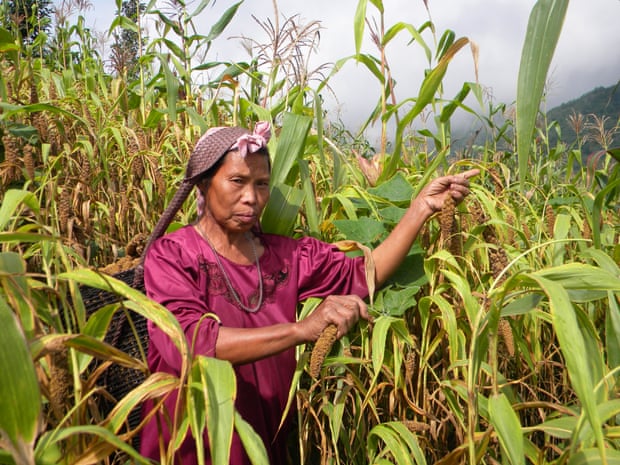Read full article @ The Guardian Photo Credit: NEN Nagaland
Nagaland farmers are bringing back the ancient crop – said to have near-miraculous powers – as a less water-intensive alternative to rice
Whülü Thurr is a staunch believer in ancient farming traditions. “There is an old adage,” she says, “which goes ‘even a single stalk of millet can revive a dying man’.”
The 65-year-old farmer, from New Phor village in Nagaland state, north-east India, is a devotee of the ancient grain millet, and is well versed in its nutritional benefit. She is one of the few farmers here who has stayed with the traditional crop over the decades. Many other farmers in Nagaland, the majority of whom are women, have stopped growing it due to a lack of demand.
White rice, easily available both in markets and via the government public distribution system – which sells it at a subsidised rate – is preferred by consumers across the state.
But growing rice requires large quantities of water, which makes it vulnerable to the effects of the climate crisis.
Faced with a changing climate, Thurr and other farmers are now working to bring millet back to the region and encourage more people to eat it.
Thurr joined the Millet Farmers Group, created by the Nagaland chapter of North East Network (NEN), a women’s rights non-profit organisation.
Through the network, 200 millet farmers from 11 villages in the district of Phek are sharing knowledge, increasing their output, and accessing new markets. Thurr says she has seen her yields increase since she joined the group.
NEN Nagaland also provides interest-free loans of between 1,500 and 2,000 rupees (£16 and £21) to millet farmers. And it is trying to build demand for the grain, including producing a cookbook featuring baked goods, fried snacks, sweets and pancakes – all made from millet flour – aimed at a younger urban audience.
“Before joining NEN and the Millet Farmers Group, the millet I grew was only for my family. With the increased production, I now have a surplus which I’m able to sell,” says Thurr. “This money is very helpful towards meeting our household expenses as well as for our medical needs.”
Wekoweu Tsuhah, the Nagaland state director of the network, says: “Rice farmers here were already affected by climate change. We’ve had erratic rainfall, rising temperatures, new pests and new crop diseases. So, in 2010–11, we began focusing on millet farming as a way to ensure food security and build climate resilience.
“Millet needs very little water, grows well on poor soil, is fast growing and suffers from very few diseases. Once harvested, it stores well for years. We see growing millet as a tool to empower local women farmers in the face of climate change.”
Foxtail is the most commonly cultivated type of millet in the region, but other varieties such as sorghum, proso and pearl are also being grown to ensure diversity. Many farmers grow crops to feed their families but some of the bigger producers also sell their output.
As well as trying to improve access to markets, NEN Nagaland has helped some of the women to buy dehusking machines. Without access to these machines farmers had to dehusk the grain manually, which put many off millet as a crop.
“For years after I resumed millet farming in 2013, I did not have a dehusking machine. I had to manually pound the grain to dehusk it. It took up a lot of my time and energy as I had no help – these activities are considered to be a woman’s job. But I persisted. It was important to me to cultivate this traditional crop,” says Povelu Shijo, a farmer from Phuhgi village.

